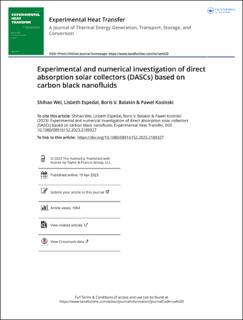| dc.contributor.author | Wei, Shihao | |
| dc.contributor.author | Espedal, Lisbeth | |
| dc.contributor.author | Balakin, Boris | |
| dc.contributor.author | Kosinski, Pawel Jan | |
| dc.date.accessioned | 2023-06-30T08:15:28Z | |
| dc.date.available | 2023-06-30T08:15:28Z | |
| dc.date.created | 2023-05-16T10:50:24Z | |
| dc.date.issued | 2023 | |
| dc.identifier.citation | Experimental heat transfer. 2023, . | en_US |
| dc.identifier.issn | 0891-6152 | |
| dc.identifier.uri | https://hdl.handle.net/11250/3074649 | |
| dc.description.abstract | Direct absorption solar collectors (DASCs) typically achieve high efficiency due to the volumetric heat absorption process facilitated by the working fluids. In this study, carbon black (CB) nanofluids were utilized as the working fluid to experimentally and numerically investigate the thermal performance of a rectangular DASC. The findings suggest that the nanoparticles have the potential to enhance the efficiency of the DASC.
Direct absorption solar collectors (DASCs) are known for their high efficiency, which is achieved through the volumetric heat absorption process provided by the working fluids In this study, carbon black (CB) nanofluids were used as these working fluids to study the thermal performance of a rectangular DASC. The experiments were conducted using water and nanofluids with 0.05 wt.% nanoparticle concentration, at different flow rates and tilt angles, under a concentrated simulated solar power source. Our results show that the efficiency of the DASC increased as the flow rate increased. The DASC was more efficient when the receiving surface was facing downwards (tilt angle of 0°), and the efficiency was 35% higher than when the receiving surface was facing upwards (tilt angle of 180°). A computational fluid dynamics (CFD) model, which was validated against our experimental results, analyzed the DASC performance under different CB concentrations. According to the simulations, the highest efficiency occurred at a concentration of 0.05 wt.%. The study also highlighted the distribution of temperature and velocity of the nanofluids, as well as the volume fraction of carbon black during the flow process. | en_US |
| dc.language.iso | eng | en_US |
| dc.publisher | Taylor and Francis Group | en_US |
| dc.rights | Navngivelse 4.0 Internasjonal | * |
| dc.rights.uri | http://creativecommons.org/licenses/by/4.0/deed.no | * |
| dc.title | Experimental and numerical investigation of direct absorption solar collectors (DASCs) based on carbon black nanofluids | en_US |
| dc.type | Peer reviewed | en_US |
| dc.type | Journal article | en_US |
| dc.description.version | publishedVersion | en_US |
| dc.rights.holder | © 2023 The Author(s) | en_US |
| dc.source.pagenumber | 22 | en_US |
| dc.source.journal | Experimental heat transfer | en_US |
| dc.identifier.doi | 10.1080/08916152.2023.2189327 | |
| dc.identifier.cristin | 2147774 | |
| cristin.ispublished | true | |
| cristin.fulltext | original | |
| cristin.qualitycode | 1 | |

